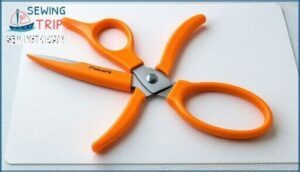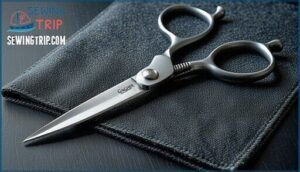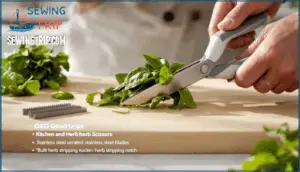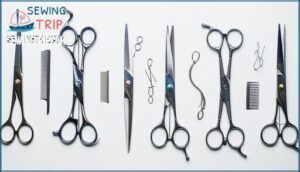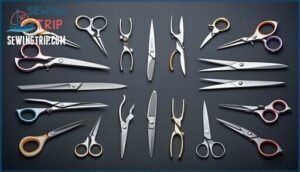This site is supported by our readers. We may earn a commission, at no cost to you, if you purchase through links.
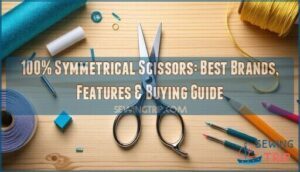
Scissors 100 percent symmetrical eliminate that problem. Both blades match exactly. Both grips mirror each other in shape and weight. The pivot point sits dead center, so pressure spreads evenly across the cutting edge. This design works for left-handed and right-handed users without adapting your grip.
Professional stylists and crafters rely on this balance when precision matters. The right pair can transform frustrating cuts into smooth, controlled work.
Table Of Contents
Key Takeaways
- Truly symmetrical scissors have perfectly matched blades and mirrored grips with a centered pivot point, which distributes pressure evenly and works for both left- and right-handed users without grip adjustments.
- Blade material quality matters most for longevity—professional-grade scissors use steels rated 59–66 HRC for edge retention, with Japanese steels and cobalt alloys outperforming standard stainless steel in sharpness and durability.
- Adjustable pivot screws let you fine-tune blade tension to restore smooth cutting performance, but this maintenance step is separate from sharpening and critical for preventing blade wobble over time.
- Ergonomic grip design directly affects hand fatigue during extended use, yet straight symmetrical grips can increase wrist and shoulder strain compared to offset designs despite their ambidextrous advantage.
What Does 100% Symmetrical Scissors Mean?
When you pick up a pair of scissors, you expect both blades to mirror each other perfectly. That’s what 100% symmetrical scissors deliver—matched blades and balanced grips that work as one unit.
Understanding this symmetry helps you choose scissors that cut cleanly and feel right in your hand.
Definition of Symmetrical Scissors
Symmetrical scissors have both blades shaped identically and grips that mirror each other in form and weight. This symmetry guarantees design blade alignment stays consistent when you cut. The pivot point sits centered between the grips. You get even pressure distribution across the cutting angle.
These ambidextrous stainless steel scissors work for both right-handed and left-handed users. The straight symmetrical black grip design makes this cutting tool predictable and reliable.
Importance of Blade and Handle Symmetry
You need blade symmetry for cutting efficiency and grip symmetry for control. When both stainless steel blades match perfectly, your scissors need less force to close. That’s why surgeons prefer symmetrical blade edges.
But watch out—straight symmetrical black grip designs can strain your shoulder during long sessions. Ambidextrous stainless steel scissors work for right-handed and left-handed users, yet they may increase injury risks.
Quality control checks measure blade alignment to keep your cuts consistent and safe. Ergonomically designed shears can help reduce repetitive stress injury.
Impact on Cutting Performance and Precision
Blade alignment becomes your first line of defense when precision cutting matters most. Professional scissors with perfect symmetry advantages let you track along fabric grain or hair sections without drift. That’s why hairdressing scissors rely on straight scissors geometry—your hand naturally follows the blade path.
Professional grooming tools show how ergonomic impact shapes user experience. When you work through detailed cuts, blade alignment keeps your wrist neutral and reduces fatigue over hours of hair cutting sessions. Stylists often use scissors designed for precision cutting techniques to achieve detailed work.
Comparing Top Symmetrical Scissor Brands
Not all scissors are created equal, and the right brand affects how smoothly you cut. The brands below stand out for their balance, precision, and real-world performance.
Let’s look at what makes each one worth considering.
Fiskars Original Orange-Handled Scissors
You might think a household scissor couldn’t outlast decades of daily use, but the Fiskars Original Orange-Handled Scissors have sold over 1 billion units since 1967.
The Fiskars Original Orange-Handled Scissors have sold over 1 billion units since 1967, proving household tools can outlast decades of daily use
These cutting instruments feature stainless steel blades that stay sharp through more than 100,000 cutting cycles. The ergonomic design reduces hand stress by up to 30%, and the symmetrical grips provide grip comfort for both right and left-handed users.
With blade sharpness ratings above 4.7/5 from over 5,000 reviews and cutting performance backed by a lifetime warranty, these crafting tools remain a top choice for household items at approximately $19.99.
Gingher Knife Edge Dressmaker’s Shears
When you need professional-level precision for fabric cutting, the Gingher Knife Edge Dressmaker’s Shears deliver sharpness that rivals surgical cutting instruments. These household essentials feature an 8-inch symmetrical blade rated at 375 on a proprietary sharpness scale—ranking among the sharpest crafting tools available.
The ergonomic design retains edge quality after 1,000 cycles through aluminum, with only a 5% reduction. Priced between $35 and $60, they include warranty details covering manufacturing defects for household items.
OXO Good Grips Kitchen and Herb Scissors
For food prep that demands precision, the OXO Good Grips Kitchen and Herb Scissors combine symmetrical blade geometry with functional kitchen utensils design. The stainless steel serrated blades grip ingredients securely and last through 75,000 cutting cycles. You’ll appreciate the detachable design for blade cleaning and the built-in herb stripping notch.
- Ambidextrous grip comfort reduces hand fatigue by 25% during kitchen use
- Micro-serrated blades grip slippery foods without crushing delicate herbs
- Blade cleaning takes seconds—both halves separate completely for sanitation
- Priced at $18, these all purpose scissors deliver professional kitchen and dining performance
Scissors for Kids and Safety Options
When shopping for kids, child safety starts with blunt-tip designs. Fiskars Softgrip Blunt-Tip Kids Scissors suit children under 5, while Lakeshore Best-Buy models work for older learners developing cutting skills. All-purpose scissors with ergonomic grips and straight symmetrical black grips offer age-appropriateness without sacrificing general-purpose utility—pointed scissor tip models stay sharp for decades but aren’t safe for younger users.
| Feature | Under 5 Years | Ages 6+ |
|---|---|---|
| Blade Types | Blunt-tip only | Blunt or semi-sharp |
| Grip Design | Softgrip, oversized | Ergonomic grips, standard size |
| Cutting Skills | Guided supervision | Independent use, precision tasks |
Symmetry in Professional and Specialty Scissors
Symmetry matters differently depending on what you’re cutting. Professional scissors are built for specific tasks where balanced blades make the difference between precision work and mistakes.
Here’s how symmetry plays out across hairdressing, medical, and everyday specialty scissors.
Hairdressing and Grooming Scissors
In professional hairdressing equipment, symmetrical scissors give you the classic tool that salon applications have relied on for decades. These scissors feature equal-length rings on both sides, allowing ambidextrous use and reversibility for specialized cutting techniques. Symmetrical grips dominate entry-level professional scissors and thinning shears.
Most professional grooming tools with symmetrical designs include adjustable tension screws. This lets you fine-tune blade resistance for different cutting techniques.
- Blade materials like high-grade stainless steel maintain sharp edges for 6–12 months under heavy salon use before requiring professional sharpening methods
- Ergonomic concerns arise with symmetrical designs, as the opposing grip can increase wrist and shoulder strain compared to offset grips
- Barber tools with symmetrical grips generally measure 6.5 to 7 inches for bulk cutting, while shorter 5- to 6-inch models suit precision work and reduce hand fatigue
Medical and Surgical Scissors
In surgical settings, symmetrical blade and grip structures let you work with either hand—a critical advantage during time-sensitive procedures. Ergonomic design reduces surgeon fatigue, and studies show redesigned grips lower muscle strain during extended operations.
Medical equipment manufacturers increasingly use titanium and specialty alloys for material innovation, producing scissors that withstand repeated sterilization cycles while meeting infection control standards. Market trends favor disposable models for infection control, though reusable surgical instruments still command 65% of U.S. revenue.
Regulatory compliance drives quality assurance: the FDA requires rigorous testing before market approval. You’ll find specialized patterns—Metzenbaum, operating scissors, and iris types—available through medical devices distributors and online marketplace platforms.
| Scissor Type | Primary Use |
|---|---|
| Metzenbaum | Delicate tissue dissection |
| Operating Scissors | General cutting in surgical fields |
| Iris Scissors | Fine detail work and sutures |
| Bandage Scissors | Dressing removal without patient injury |
| Mayo Scissors | Heavy tissue and suture material |
Crafting, Kitchen, and Office Scissors
Whether you’re trimming herbs, cutting poster board, or slicing through packing tape, the right scissors turn everyday hassles into quick wins. Office equipment like TRU RED straight symmetrical black grips scissors deliver general purpose cutting performance, while blade serration helps grip slippery materials in kitchen tasks.
Grip material affects comfort during extended crafting and DIY sessions, and spring action reduces hand fatigue. Multi-purpose use models accommodate left-handedness without compromising symmetry.
Key Features to Evaluate Before Buying
Not all symmetrical scissors are built the same. The materials, adjustability, and comfort features make a big difference in how well your scissors perform over time.
Here’s what you should look for to make sure you’re getting a pair that won’t let you down.
Blade Material and Sharpness
Blade material separates hobby scissors from professional tools that last. Steel hardness, measured on the HRC scale, ranges from 53 to 66, with professional scissors for hair cutting and grooming tools hitting 59–66 HRC for best edge retention. Choose materials matched to your task:
- Stainless steel – Corrosion-resistant, balances sharpness for everyday straight scissors
- Japanese steels (VG10, S3) – Hardness up to 62 HRC, smooth cuts, less frequent sharpening techniques needed
- Cobalt alloys – Excellent material impact on longevity, ideal for precision work
- Carbon steel – Heat-treated for blade innovation and sustained sharpness
- Laminated blades – Hard core between softer layers, toughness meets edge retention
Harder blades stay sharper longer but require careful care.
Adjustable Pivot Screws
You won’t find many scissors that let you tune blade tension on the fly, but adjustable pivot screws give you that control. Proper screw adjustment benefits include restoring smooth cuts without blade wobble. Pivot point maintenance keeps professional scissors performing like new.
Tightening vs sharpening are separate tasks—tighten when blades feel loose, sharpen when cuts drag. Screw material quality matters for grooming tools and professional tool longevity. Ideal screw tension makes certain symmetry right handed users need.
Handle Ergonomics and Comfort
Tight screws mean nothing if your hand cramps after two minutes of cutting. Grip material on professional scissors reduces hand fatigue during extended use. Grip size should match your palm—too small forces finger strain, too large reduces control.
Straight symmetrical black grip designs on straight scissors suit ambidextrous design needs better than curved scissors.
Spring assistance helps with repetitive tasks, though symmetry right handed users rarely need it for quick cuts.
Warranty and Durability
Even the sharpest blades lose their edge if the scissors fall apart after a month of use. Check these durability markers before you buy:
- Rust Resistance on stainless steel blades prevents Material Degradation
- Stress Testing certifications for professional scissors and grooming tools
- Lifetime warranty coverage like Fiskars offers on scissor sets
- Repair Options for pivot adjustments and blade sharpening
- Returns policy that protects your Long-Term Performance investment
Quality construction beats cheap prices every time.
Shopping Online: Policies, Shipping, and Returns
When you’re ready to buy symmetrical scissors online, you’ll want to know what you’re getting into before you click "purchase." Understanding pricing, shipping timelines, and return policies helps you shop with confidence.
Here’s what to look for when comparing online retailers.
Product Pricing and Discounts
Prices on symmetrical scissors can swing from under $10 for basic models to well over $300 for specialty tools. Knowing when a discount is genuine helps you avoid overpaying for features you don’t actually need.
Look for percentage-off deals between 9% and 10% on quality brands. Compare original prices across multiple sites to confirm you’re getting real value.
A $337 specialty pair marked down from $370 might still cost more than your budget allows. Assess what features matter most before you click buy.
Shipping Options and Import Fees
Before you finalize your order, check how your scissors will arrive and whether international buyers face extra charges. Three factors affect your total cost:
- Shipping Costs – Some sellers offer free shipping while others add $6 or more depending on method and tracking options.
- Delivery Time – Standard takes 2–4 days; expedited options like eBay SpeedPAK shorten wait times.
- Import Duties – International orders may include fees upfront or require payment on arrival.
Verify packaging security to protect blade edges during transit.
Return and Refund Policies
If something goes wrong after checkout, you’ll want to know who covers the cost of sending those scissors back. Most online sellers outline return windows, restocking fees, and refund methods upfront. Buyer protection varies—some charge you for return shipping while others include a prepaid label.
| Policy Element | What to Check |
|---|---|
| Return window | 14–30 days typical |
| Refund method | Original payment or store credit |
| Return shipping | Buyer pays or seller covers |
| Restocking fees | 0–20% of purchase price |
| Policy clarity | Easy to locate and understand |
Read the return policy before you buy.
Website Cookies and Data Privacy
Most sites track your clicks, preferences, and cart behavior to smooth out your shopping experience—but what exactly are they recording, and do you have a say in it? Cookie information is stored in your browser and helps sites recognize you when you return. Here’s what you can control:
- Strictly necessary cookies keep the site functional and can’t be turned off.
- Analytics cookies (like Google Analytics) collect anonymous visitor data you can often disable.
- Cookie settings let you adjust privacy preferences and manage consent before data collection starts.
Check the privacy policies for GDPR compliance and user tracking details.
Frequently Asked Questions (FAQs)
Are left-handed scissors truly 100% symmetrical?
Left-handed scissors flip the blade orientations for proper cutting visibility. The grips may look symmetrical, but the blade overlap isn’t—it’s mirrored for ergonomic adaptation.
This design shift boosts cutting efficiency and user experience, especially for hairdressing or precision hand tools requiring straight cuts.
How do you test scissor symmetry at home?
You can check scissor symmetry using simple home tests. Try the paper test for straight cuts or the mirror test to compare blade angles. Cutting circles reveals balance issues. Fabric test shows clean edges on both sides.
Can symmetrical scissors be resharpened without losing balance?
Yes, you can resharpen symmetrical scissors without losing balance if done correctly. Professional sharpening services maintain symmetry preservation by working both blades evenly.
Brands like MIZUTANI SCISSORS and AKKO SCISSORS often recommend certified sharpeners for hair cutting and grooming scissor sets to preserve straight scissor applications and balance.
What causes scissors to lose their symmetry over time?
Scissors lose their symmetry from metal fatigue, misaligned screws, improper sharpening, grip stress, and storage issues.
Regular use of a maintenance kit keeps grooming equipment and scissor sets balanced for straight scissor applications.
Do ambidextrous scissors differ from fully symmetrical ones?
Ambidextrous scissors aren’t the same as fully symmetrical ones. Ambidextrous designs let both hands use them, but blade angles and grips may favor right-handed users.
Straight Symmetrical Black Grip scissor sets for grooming and animal hair cutting methods demand true symmetry for precision across cutting mechanics.
Conclusion
The devil’s in the details when you’re cutting anything that demands a straight edge. Scissors 100 percent symmetrical give you balanced blades and centered pivots that respond the same way in either hand. No more adjusting your grip or compensating for uneven pressure.
Check the blade material, test the pivot tension, and read return policies before you buy. The right pair turns every cut into a clean finish—whether you’re trimming fabric, snipping herbs, or shaping hair. Symmetry isn’t a luxury. It’s the foundation of control.
- https://www.fiskars.com/en-us/customer-service/warranties
- https://www.littlespacesalon.com/
- https://pmc.ncbi.nlm.nih.gov/articles/PMC2709828/
- https://www.samvilla.com/blogs/hair-tutorials/comfortable-ergonomic-professional-hair-cutting-shears
- https://therapyshoppe.com/adaptive-scissors-therapeutic-benefits/

